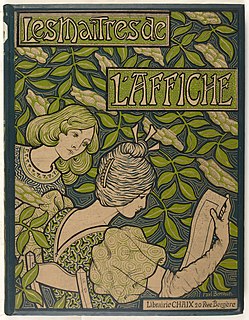 W
WAmbassadeurs is an 1892 lithograph poster by French artist Henri de Toulouse-Lautrec. The subject of the poster is Toulouse-Lautrec's friend cabaret singer Aristide Bruant.
 W
WDivan Japonais is a lithograph poster by French artist Henri de Toulouse-Lautrec. It was created to advertise a café-chantant that was at the time known as Divan Japonais. The poster depicts three persons from the Montmartre of Toulouse-Lautrec's time. Dancer Jane Avril is in the audience. Beside her is writer Édouard Dujardin. They are watching a performance by Yvette Guilbert. Though her face is not included in the poster, she is recognizable by her tall, thin frame and long black gloves.
 W
WThe Holy Land, Syria, Idumea, Arabia, Egypt, and Nubia was a travelogue of 19th-century Palestine and the magnum opus of Scottish painter David Roberts. It contained 250 lithographs by Louis Haghe of Roberts's watercolor sketches. It was first published by subscription between 1842 and 1849, in two separate publications: The Holy Land, Syria, Idumea and Arabia and Egypt and Nubia. William Brockedon and George Croly wrote much of the text, Croly writing the historical, and Brockedon the descriptive portions.
 W
WMaîtres de l'Affiche refers to 256 color lithographic plates used to create an art publication during the Belle Époque in Paris, France. The collection, reproduced from the original works of ninety-seven artists in a smaller 11 x 15 inch format, was put together by Jules Chéret, the father of poster art.
 W
WTen Dollar Bill is a 1956 proto-pop art lithographic drawing by Roy Lichtenstein. Considered to be a combination of Americana art and cubism, the work is referred to as the beginning of Lichtenstein's work on pop art. Twenty-five editions of the lithograph were made by Lichtenstein, which were exhibited at several galleries. The piece is based on the design for the ten-dollar bill and has influenced several of Lichtenstein's later works. The picture has received generally favorable reception from critics, and is considered to be one of the best artistic portrayals of currency.
 W
WThe Pantheon, from the Terrace of the Luxembourg Gardens is a lithograph by the American artist James Abbott McNeill Whistler, created in 1893.
 W
WList of drawings by Vincent van Gogh is an incomplete collection of drawings by the Dutch artist Vincent van Gogh (1853–1890) that form an important part of his complete body of work. The listing is ordered by year and then by catalogue number. While more accurate dating of Van Gogh's work is often difficult. As a general rule the numbering from Jan Hulsker's catalogue is more precise chronologically
 W
WZapata (1932) is a lithograph by the Mexican artist Diego Rivera (1886–1957) that depicts the Mexican revolutionary Emiliano Zapata (1879–1919) as he holds the reins of a horse among a group of campesinos (peasants). The lithographic edition was created and printed twelve years after Zapata's assassination. Zapata is based on Agrarian Leader Zapata (1931), one of eight "portable" frescoes produced explicitly for Rivera's solo exhibition at the Museum of Modern Art (MoMA) in 1931, which was adapted from his previous Revolt panel from a fresco titled The History of Cuernavaca and Morelos (1929–30) painted in the Palace of Cortés, Cuernavaca. There were 100 original prints of the lithograph, many of which are in the collections of various art museums.